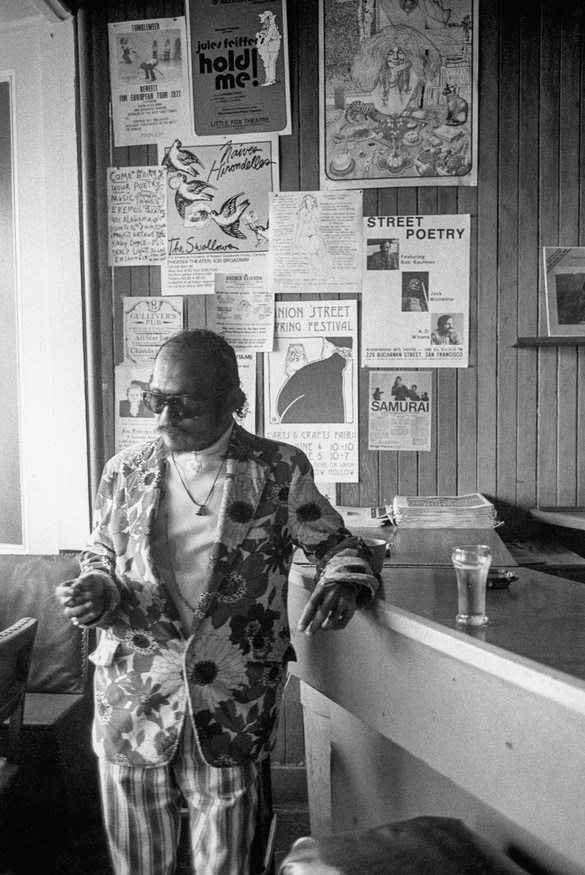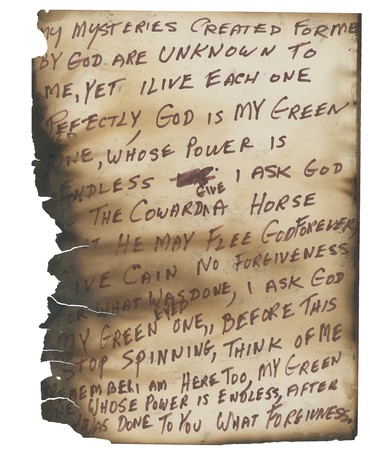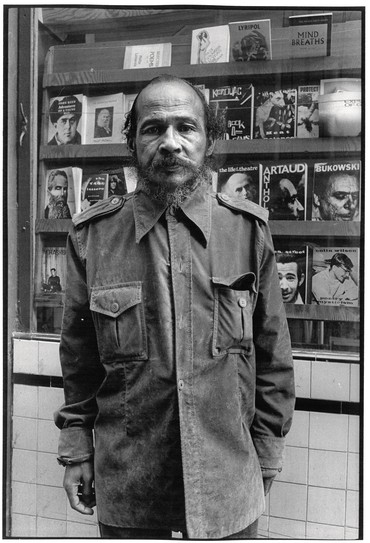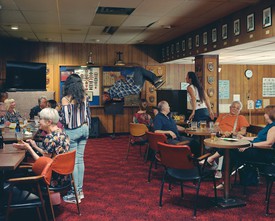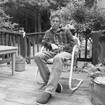
Raymond Foye is a contributing editor to the Brooklyn Rail. His most recent publication is Harry Smith: The Naropa Lectures 1989–1991 (2023). Photo: Amy Grantham
I first encountered that remarkable face on the cover of a battered paperback, Solitudes Crowded with Loneliness (New Directions, 1965), in a used-book store in Lowell, Massachusetts, in 1972. If you want to know about Bob Kaufman, just look at the many remarkable photographs of him, as they really tell it all: the power of one man, small in stature, staring into you with dignity and defiance, tenderness and humor. His face is a map: of Africa, of the West Indies and the Caribbean, of his beloved New Orleans and the birth of jazz. It is the face of a holy man on Earth as a hero and martyr in the guise of a hipster and flaneur.
From this photograph I first sensed what in the Hindu tradition is called darshan: the transformation felt in a master’s presence, communicated through the gaze. At any rate, I did judge a book by its cover . . . and quickly purchased it. As I read the first poem, “Private Sadness,” I immediately fell under the spell of its gentle yet vivid imagery. Bob’s lofty language drew a straight line from Shakespeare to the Harlem Renaissance, while his stately cadence, always so rhythmic and dignified, carried me along like the steps of a funeral jazz band following a hearse through the French Quarter. A few months later I found his second book, Golden Sardine (City Lights, 1967). Once again the cover photograph of that same wise face gazed at me with understanding. His books were slim and I essentially memorized them. I intuitively understood these poems were oral/aural: they sprang not from the written word but from Orpheus’s lyre. I carried these two books with me as I traveled, always placing them on the shelf with their photographs facing out.
Seeking adventure at the age of nineteen, I arrived in San Francisco on January 1, 1977, and checked into a North Beach hotel near the City Lights bookstore. The Tevere Hotel was located in the narrow triangle of land formed by the intersection of Grant and Columbus Avenues and bounded on the north side by Vallejo Street. My room was above the Caffe Trieste and overlooked the Saloon. As I walked down the narrow flight of stairs to the street one morning, a familiar face passed me by. Stunned, I turned to ask, “Are you Bob Kaufman?” Without stopping, and without turning around, he replied, “Sometimes.”
In those days Bob was more an apparition than someone real. He was an otherworldly but not unnoticed specter of the bohemian quarter known as North Beach. I have never known anyone whose presence was so defined by absence. By then he had already retreated into silence and isolation, so for months I watched him from afar as he haunted the streets and alleys like Edgar Allan Poe’s “man of the crowd,” never speaking, never stopping, until one evening when he suddenly walked into Specs’ Bar and began booming out poetry at the top of his voice: “Let us go then, you and I, / When the evening is spread out against the sky / Like a patient etherized upon a table.” He recited T. S. Eliot’s “Love Song of J. Alfred Prufrock” in its entirety and then somebody bought him a beer. More poetry followed: Charles Olson’s “Kingfishers,” with the line “What does not change / is the will to change,” and Wallace Stevens’s “Peter Quince at the Clavier,” with the line “Music is feeling, then, not sound.” Soon I learned that Bob alternated between silent periods when he did not drink and boisterous periods when he did. Each period lasted six or eight months. We all waited for those boisterous periods, because otherwise he was entirely unreachable.
Bob was forever walking around with great determination, which always made me wonder just where he was going. One day I spied him through the window of City Lights and decided to follow him, trailing far enough behind that he wouldn’t see me. He walked down Columbus to Kearny, then on through South of Market for another dozen blocks until he reached China Basin. These were the docks of old San Francisco Bay, for him a kind of home. Pressed up against a chain-link fence for over an hour, he watched the ships come and go, the loading and the unloading. It was then that I saw the old merchant seaman in him—the young boy who went to the sea in his teens and stayed on the ships for seven years, traveling around the world and spending his shore leave in exotic ports like Calcutta, where he spent five weeks. I came to learn a lot about this part of his life from a fellow seaman and veteran of the Spanish Civil War, a rough character named Henry Thomas, who drank 151-proof rum at the Savoy Tivoli bar on Grant Avenue. He was notorious for singing “The Internationale” and other communist anthems when he was drunk. Henry told me that Bob was known for taking on the toughest jobs, like climbing the mast during a storm to tie down rigging.1
In the North Beach days Bob was living off a paltry check from state assistance. Around the first of the month I would often see him having breakfast, his one meal of the day, at a lunch counter he liked called Curley’s on Green and Columbus. By the middle of the month the regular meals would end and he would have to get by on what he could bum from friends. One day he came up to me and said, “Hey Raymond, can I have a dollar?” It was very early in our acquaintance and I was surprised that he even knew my name. I remember thinking to myself in astonishment as I handed him the money, “Bob Kaufman just said my name.” A week later he approached me and said, “Hey Raymond, can I have five dollars?” And I handed it over. A week later he walked up to me and asked for ten—the following week, twenty. The next time I saw him he casually approached and asked, “Hey Raymond, can I have a hundred dollars?” I laughed, then he did too, and after that the amount he would ask for went back down to five.
In those days I made it my mission to collect as many stray poems of Bob’s as I could, from early mimeo zines like Beatitude or from friends of his who had preserved the poems he’d scribbled on napkins and scraps of paper. My mentor in this regard was his wife, Eileen Kaufman. She had been responsible for preserving most of the poems in Solitudes. The two were estranged at the time: she could not control his behavior and he would not accept control. I preserved these poems in a folio, hoping one day to publish a book that would add to the legacy of Solitudes and Golden Sardine.
After the Tevere Hotel, I moved to 28 Harwood Alley (since renamed Bob Kaufman Alley), into the very room Bob had briefly occupied, an apartment I shared with the poet Neeli Cherkovski. That kitchen was the center of social life for the poets of North Beach, and it was crowded from morning till night with the likes of Gregory Corso, Kirby Doyle, Howard Hart, Kaye McDonough, Tisa Walden, Lawrence Ferlinghetti, and dozens of others. Philip Lamantia lived across the alley and our kitchen windows looked directly into each other’s. When Philip was in a social mood he would open his window and say hello, a discussion would ensue, and eventually (sometimes after an hour) he would come over for coffee and stay several hours more. Bob was also a regular. I had tacked photographs of him on the kitchen door along with broadsides and fliers for bygone readings. “What am I, the local hero?” he said with a smile one day looking at the photos. On one occasion he even picked up a broadside of his poem “Second April” and gave an impromptu reading. “I feel at home in this neighborhood,” he told me one day. “When I’m lost and alone, and Paul Robeson is singing the Soviet national anthem in my head, and I can’t sleep, I go out and walk these streets, and I feel at home.”
I was in my room listening to a Dizzy Gillespie record one day when Bob stopped by. He walked in singing scat along with the solo—singing on key and note for note, with absolute precision, as if he had a transcription of the music in his head (which clearly he did). It was then that I realized the depth of his involvement with bebop, how this music was at the core of his work. I never read his work again without hearing those complex rhythms, with their streaming melodies and switchback changes: he had stolen their essence with his ears. But the same can be said for many other influences that he absorbed in their totality and then made his own—Federico García Lorca, for instance. There is still so much like this to be unpacked from his poetry.
Sometimes if Bob was in the mood I would visit him at the Dante Hotel. His room was just upstairs from a strip joint, the Condor. We would share a joint and look at art books, of which he had quite a nice collection stacked in piles on the floor. He would buy them from a used-book store directly downstairs on Broadway. (This was the only extravagance I ever really knew him to indulge in.) He loved Picasso, Miró, Klee, Van Gogh, and the Impressionists. I remember him staring silently for a very long time at a reproduction of Van Gogh’s Night Café, at last remarking, gesturing to the cosmos, “Van Gogh is out there, really out there. I mean, he’s not coming back.” Bob’s favorite book was The Image of the Black in Western Art, a multivolume history first published by the Menil Foundation beginning in the mid-1970s (and later revised and expanded by David Bindman and Henry Louis Gates, Jr.). At one point he found a full-page reproduction of a carved wooden mask from Benin that bore a remarkable resemblance to him, a point he silently underscored by holding the book up directly beside his face while staring back at me. After not seeing him for a few months during a silent period, I ran into him and asked if he wanted to hang out in his room. “I threw my marijuana out the window,” he replied, and walked away.
Bob had a lot of personal quirks, some of which could be quite annoying. If he turned on the faucet, he never turned it off: he just walked away and left the water running. Once I drove him to a barbecue at his brother George’s house in Oakland, and both times when he left the car he didn’t close the door behind him. Eventually I just chalked these things up to his “living in the moment.” One of the more eventful aspects of encountering him was his wardrobe. I never knew anyone with a better sense of style: fabrics, colors, hats. I often wondered how he managed this on his budget. One day he was walking toward me and I noticed he was particularly well-dressed in a white dinner jacket and a green-striped silk scarf. Suddenly I realized it was my jacket and scarf—he’d just raided my closet on Harwood Alley. He smiled and gave me a big hello and kept moving.
Although Kaufman’s personal biography reads quite tragically, full of police beatings, jails, and enforced asylums, he could be light-hearted and a lot of fun to be around. The way his humor came through in his body language reminded me of the silent-film comedians: like Buster Keaton or Harold Lloyd he was small in stature but extremely strong. He had a great sense of physical comedy and a sharp sense of timing, full of double takes and mock surprise. Once he entered City Lights just as a car backfired in the street, and without missing a beat he clutched his heart and staggered through the door exclaiming, “They’ve shot Bob Kaufman!” His remarks were always terse and often charged with a strong sense of the absurd. I remember him sitting silently at a café table with Ginsberg for nearly an hour when he suddenly looked up and announced with astonishment, “Mars is a red planet!” When I first got to know him I mustered the courage to ask if he was still writing. “Sometimes I want to sing, but I get laryngitis of the soul.”
In 1979, Neeli and I edited a special twentieth-anniversary issue of Beatitude dedicated to Kaufman, whom we both felt was criminally neglected. Bob had cofounded the magazine in 1959, but by 1979 it had languished. Kaufman’s co-publisher, Pierre Delattre, referred to it as “a floating crap game,” meaning anyone who wanted to edit an issue could. Publishing this anniversary issue was more or less the beginning of a small renaissance of interest in Bob, the point when the next generation picked up on his work and a dozen or more young poets gathered around him. Indeed, a short while after the issue was published and promoted with various readings in which he participated, I ran into him in a bar one afternoon. He took me by the arm and presented me to a friend, announcing proudly (and quite uncharacteristically), “This thing we started in the ’50s, this Beat Generation, it didn’t end back then, it continues.” This was exactly as I had quoted from Ezra Pound in my Beatitude essay on Kaufman: “To have gathered a live tradition from the air, or from a fine old eye the unconquered flame.”
Early one morning as I made my way down to the Caffe Trieste, I encountered Bob shuffling around on the sidewalk outside, mumbling something about having survived Dante’s Inferno. I assumed it was his usual way of speaking in metaphors. An hour later someone told me that the Dante Hotel, where he lived, had burned. And indeed it had. First I thought of his small room, the art books lost, and so on, and then I wondered about his poems. I had no idea whether he had been writing in those years because he would never say, but the possibility was there. An instinct told me to make some moves. I waited for the fire crew to depart a few days later, after the building had stopped smoldering, and I crossed the police lines. It was a vast hotel full of cubicles, but fortunately I knew exactly where his room was. It was in the most charred part of the building; in fact the fire may have actually started in his room. His chest of drawers was reduced to a small pile of charcoal. I dug through the things that didn’t burn, the coins and religious medallions. At the bottom of the pile was a thick Moroccan-leather binder, soaked with water. I looked inside and glimpsed pages bearing his distinctive handwriting, lettered in both small and large capitals. I took the binder and walked across the street to City Lights, where I’d been working as an editorial assistant for a few months. I carefully peeled off the manuscript pages and laid them out all around the upstairs office. I can still recall Ferlinghetti’s look of amazement when he came in to work around 10 a.m. To those few of us for whom Kaufman was a true poetic genius, it was like a door opening into King Tut’s tomb. He had been writing all those years, and the poems bore the mark of that unmistakable mind and imagination:
i am a camera
the poet nailed onthe hard bone of this world
his soul dedicated to silence
is a fish with frog’s eyes,
the blood of a poet flows
out with his poems, back
to the pyramid of bones
from which he is thrust
his death is a saving grace
creation is perfect
As the poems dried out, I typed them up. Soon I realized that I had enough material to bring out the book I’d been hoping for. These new poems, when added to the ones I’d already collected, formed the second half of what would become Bob’s last book, The Ancient Rain (New Directions, 1981). But the more difficult part was that first, Bob would need to be convinced they should be published. He steadfastly refused every time I broached the subject. I enlisted Eileen to help out; she had breakfast with him and asked him why. “Because I don’t think it’s going to happen,” he replied. I understood he was protecting himself from disappointment, so I sent the manuscript to Fred Martin and Griselda Ohannessian at New Directions; they accepted it immediately. Shortly thereafter, I cornered Bob on the street one morning to show him the galleys and a contract, which to my relief he quickly signed. I also had his burnt manuscripts, which I tried to return. “I don’t want them,” he said, and abruptly walked away. The book came out with Ira Nowinski’s magnificent portrait of Bob on the cover, showing him in a Mexican poncho, holding court at the Coffee Gallery.
Having a recent publication made Bob eligible for poetry grants, so I filled out an application for the National Endowment for the Humanities, included the required poems, and got him to sign it. About six months later he came up to me on the street. “Raymond, this check is no good.” It was a U.S. Treasury check for $12,500 made out to Bob Kaufman. The bank had refused to cash it because he didn’t have a bank account. We returned to the bank and I explained it was part of their charter as a bank to cash U.S. Treasury checks, regardless of the payee’s relation to the bank. Phone calls were made and Bob became increasingly impatient, insisting that we just leave—it was obvious how much he hated any interaction with authority. Finally they agreed to cash the check. “How do you want it?” the teller asked. Bob was deaf in one ear and hard of hearing in the other, and it made him shout somewhat when he spoke. “What?” “How do you want it?” “I don’t care!” he yelled. The teller quickly counted out a stack of hundred-dollar bills and Bob stuffed them in his pocket and left. For the next several weeks every poet in North Beach was a recipient of his largesse. His wardrobe—never at a loss for stylishness—stepped up a few notches. In a month, he was broke again, but he seemed very happy.
In those days North Beach had a bar on every block, sometimes two or three, each with a different character and clientele. Bob was pretty much a regular at all of them: there was the Saloon on Grant Avenue, a tough biker bar with live blues bands where he spent many hours with the poet Janice Blue, his girlfriend of the time;2 there was the Coffee Gallery, another blues bar where guitarist Michael Bloomfield would occasionally drop by; there was Gino and Carlo’s, with a pool table and drug dealers in the backroom; there was the Columbus Café, the San Remo, Specs’, and the pricey outdoor Enrico’s on Broadway; and next to City Lights on Columbus there was Vesuvio, where Bob would often take a morning Irish coffee. But his favorite bars seemed to be those with exotic decor: the Hawaiian-themed bar on the corner of Grant and Green; the Swiss Bar on Broadway, done up like a cozy chalet in the Alps; or the Li Po in Chinatown, a masterpiece of nostalgic chinoiserie, named after the Tang-dynasty poet who reputedly drowned while drunkenly trying to embrace the reflection of the full moon in the Yangtze River. The large number of neighborhood bars came in handy for poets like Kaufman or Corso, who could become boisterous after a few drinks and were occasionally 86’d from one establishment or another. In fact on one visit back to San Francisco from New York, when I bumped into Kaufman on the street and suggested that we have a beer, I had to name three different bars before I hit on one he was allowed in at that moment.
In later years Bob took up with a kind and gentle companion, Lynne Wildey, and his life took on a semblance of domesticity—to the extent that such a thing was possible.3 The day before he died, Kaufman meticulously cleaned his room, dressed all in white, and carefully placed his favorite D. T. Suzuki book on Zen on his bedside table, before he peacefully slipped out of existence.
As a writer Kaufman often relies on seemingly fanciful or extravagant metaphors, but directly behind each of those images lie real-life experiences, these often quite dire. As a result of a beating during his days as a labor organizer in the deep South, Kaufman lost several teeth, lost all hearing in one ear, and suffered tinnitus in the other. These facts are gently masked in a simple seven-line poem:
“MICHELANGELO” THE ELDER
I live alone, like pith in a tree,
My teeth rattle, like musical instruments.
In one ear a spider spins its web of eyes,
In the other a cricket chirps all night,
This is the end,
Which art, that proves my glory has brought me.
I would die for Poetry.
Embedded in other poems you will find references to the attempted suicide of William Margolis, who jumped out a window in Harwood Alley, to the deaths of friends and to various suicides he’d known. The poem “Rue Miro” is his description of the street by that name that he grew up on in New Orleans. Each stanza in “Unhistorical Events” is about a specific friend or shipmate—Rock Gut Charlie, Cinder Bottom Blue, Riff Raff Rolfe, Lady Choppy Wine—while the final stanza describes a horrible scene from his childhood when he was chased by a lynch mob and hung by his thumbs in an ice house in Louisiana, remaining locked inside alone in agony until he was discovered the next day. The reality behind the metaphor is the glue that holds it together; the transformation of that reality is the magic of the poem.
While I enjoy recalling Bob’s exuberance and warmth, I have to circle back to his solitude. For most of the years I knew him he was determined to maintain his distance from the social, material world; one felt his solitude when one was with him, it was palpable, and almost all his remarks to me down through the years were about this place: “I live in a well of loneliness.” “I don’t know how you get involved with uninvolvement, but I don’t want to be involved.” “Wallace Stevens wrote a poem about the motives for metaphor. I want to discover my motives for metaphor.” For Kaufman, solitude was not just a metaphor, nor was it a clinical condition. His silence was a witness to an eternal truth. It was a self-imposed isolation, his need for the innermost cave where his sentience might be itself. It is where his poetry came alive without ego or worldly attachment. Fortunately, at times he emerged from that cave to speak to us through his poems.
Collected Poems of Bob Kaufman contains the first three books of poetry the poet published in his lifetime, books respectively edited by his wife, Eileen Kaufman; Claude Pelieu and Mary Beach; and myself. It also includes a generous selection of poems newly unearthed from various public and private collections and small magazines, appearing through the diligent work of Tate Swindel, who also compiled for the book a biographical chronology containing much new information. As both writer and editor, Neeli Cherkovski has supported and honored Bob Kaufman’s work for over forty years, and, perhaps more important, gave Bob a place to live when he was homeless, proving the exception to “all those people who gave me thick books to read when what I really needed was a warm meal.” John Geluardi, like his mother Alix, was and is a lifelong friend to Bob, Eileen, and Parker Kaufman.
1This might have been the least dangerous of Bob Kaufman’s tasks given that he spent virtually the entirety of World War II on Liberty ships, part of the U.S. Merchant Marine fleet. The Merchant Marines suffered the highest rate of casualties of any service in the war, with over 1,500 ships sunk at great loss of life. The important story of these ships is still not widely known.
2Bob and Janice Blue shared writing credit on a book called Closing Time till Dawn (The Bob Kaufman Collective, 1986), transcribed from their spontaneous poetry sessions, although Bob was often unhappy when people tried this approach because they didn’t understand that when he riffed he was interspersing lines by other poets along with his own—and he didn’t want to appear to be plagiarizing. For Bob, all poetry was one.
3For a touching profile of Kaufman’s life during this period see Eric Walker’s prose account “The Ancient Rain,” in Eric Walker: Selected Poems (New York: Raymond Foye Books, 2019). Also available on line at https://brooklynrail.org/2014/12/criticspage/the-ancient-ruin (yes, the last word in the link is not “rain” but “ruin.”) A brilliant but doomed poet who was found hanging in prison at age twenty-nine, Walker was Kaufman’s most direct protégé, and Kaufman even took him in for a time.
Text © 2019 by Raymond Foye; reprinted with the permission of City Lights Books, San Francisco; Collected Poems of Bob Kaufman, ed. Neeli Cherkovski, Raymond Foye, and Tate Swindell (San Francisco: City Lights Publishers, 2019)
